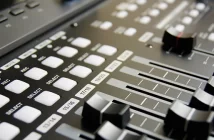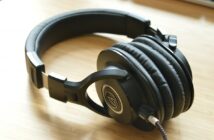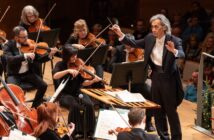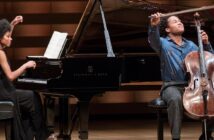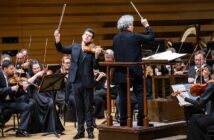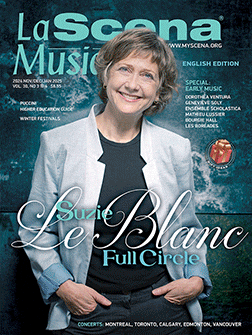
This page is also available in / Cette page est également disponible en:
![]() Francais (French)
Francais (French)
Last time we looked at what a good recording consists of for an opera singer. This time I’m proposing and comparing three microphone placements that can be used when recording a piano-voice duo.
The Natural Setup
A pair of microphones
A pair of microphones (spaced six inches from each other) facing the piano-voice duo from a certain distance (three to six feet from the singer, for example), represents the most natural setup because it corresponds well to what a listener would hear if he/she were at that distance. In addition, this position represents well the usual perspective of the audience in a concert hall. Distance is the crucial aspect here, for it determines the level of reverberation occurring between the microphones and the performers: the farther the microphones are positioned from the sound sources, the more ambient the recording is by virtue of the increased reverb level. Also, the distance between the piano and the singer determines the relative levels of the piano to the voice; for instance, if you move the piano back by a foot or two, its signal will be weaker in the microphones and allow for more presence of the voice in the mix. The one drawback with this approach is that reverb and balance between voice and piano cannot be altered once the recording is done.
The Setup with Balance Control
A pair of microphones for the piano, one microphone for the singer
If more flexibility is required, a pair of microphones can be used for the piano and a single microphone for the voice. The pair of microphones should be close to the piano and the single microphone a certain distance in front of the singer. At the mixing stage, it will then be possible to adjust the balance between voice and piano. But there will always be some bleed of the piano into the singer’s microphone, hence the need to use a microphone with a good off-axis response. But this increased flexibility presents some problems. For one, the auditory experience is not very natural in that the microphone positions give the listener the impression of being very close to the performers rather than at the usual concert-hall distance. In some genres, close miking might not be suitable, as in the case of works where the hall reverb plays an important role in the music. This procedure demands a fair amount of work at the mixing and editing stages in order to achieve a more natural kind of sound. Not only that, but the lack of reverberation is another drawback with this kind of microphone placement, the reason being that there is no microphone dedicated to the room reverberation. This can still be dealt with by moving the microphones away from each sound source, which will lessen the amount of direct signal while increasing the amount of reverberation. That, too, has its own risk, as in unwarranted interferences: the piano bleeds into the voice microphone and the voice bleeds (to a lesser extent) into the piano microphone, thereby reducing the flexibility this microphone placement technique is supposed to bring. There are other options available to increase the reverb, such as using artificial reverb at the mixing stage or using a microphone with a wider polar pattern. But such procedures do require a considerable amount of technical know-how from the user, so it may be advisable to seek assistance from an experienced sound engineer.
Optimal Balance Control
A general pair of microphones, a pair of microphones for the piano and a microphone for the singer
This approach tries to incorporate the upsides of the previous two systems and compensate for some of their shortcomings. For starters, we have a stereo pair of microphones, set up at a fair distance from the performers, picking up the general performance with plenty of reverb, we have a microphone placed relatively close to the singer, and a stereo pair of microphones placed close to the piano. These closely placed microphones are called “spot” microphones, which, having no reverb, add definition to the sources. To achieve a natural balance, all of them need to be used: if only the general microphone pair is used, the piano and voice will lack precision and definition; if only the spot microphones are used, the piano and voice will lack reverb. This approach offers a considerable degree of latitude in the mixing process. For example, the general stereo pair could account for 90 per cent of the final sound and the spot microphones only for 10 per cent. Close miking sharpens the focus of the sound sources that otherwise lose clarity because of the room reverb present in the general stereo pair. Another example would be to use mainly the spot microphones (accounting for 80 per cent of the final sound mix) and to use the reverb in the general stereo pair (20 per cent of the final sound) to link the piano and the voice. Finding a natural balance is the real challenge of the mixing process as the line separating a dry mix from a mix with too much reverb is thin. Not only that, but at times it is even more difficult to blend the three viewpoints captured by the microphones: one perspective is close to the singer, one is close to the piano, and the third vantage point is from farther away. Because of this, listeners may have a hard time locating themselves given all the vantage points they are offered simultaneously. The sound quality may be impressive, clear, and very wide stereophonically, but still come across as unnatural.
This “total control” approach has its downsides, too. For one, it’s the costliest approach. Not only from an equipment point of view (extra microphones, extra preamps, all rapidly adding to rental expenses and longer set-up times), but also a need for greater technical understanding of issues like signal phases and time delays between the different microphones to figure out—all subjects beyond the scope of this piece. As such, this approach’s assets are also its liabilities: it offers so many options that a lot of time can be wasted during the final mixing stage in trying out the different options. As one is making use of the various options, one is also delaying the decision making that is needed to reach a final mix. In a nutshell then, costs add up quickly, both in hardware and post-production studio time. For more complex recording techniques, it may be best to hire someone well versed in these matters.
TRANSLATION BY MARC CHÉNARD
This page is also available in / Cette page est également disponible en:
![]() Francais (French)
Francais (French)


